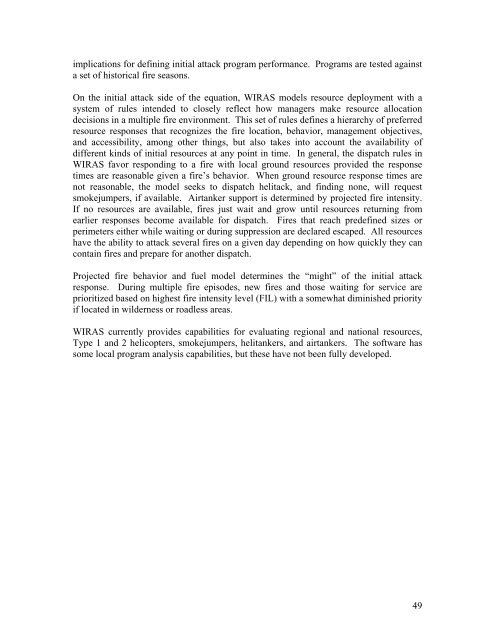Interagency Aviation Strategy - July 2008 - National Wildfire ...
Interagency Aviation Strategy - July 2008 - National Wildfire ...
Interagency Aviation Strategy - July 2008 - National Wildfire ...
Create successful ePaper yourself
Turn your PDF publications into a flip-book with our unique Google optimized e-Paper software.
implications for defining initial attack program performance. Programs are tested against<br />
a set of historical fire seasons.<br />
On the initial attack side of the equation, WIRAS models resource deployment with a<br />
system of rules intended to closely reflect how managers make resource allocation<br />
decisions in a multiple fire environment. This set of rules defines a hierarchy of preferred<br />
resource responses that recognizes the fire location, behavior, management objectives,<br />
and accessibility, among other things, but also takes into account the availability of<br />
different kinds of initial resources at any point in time. In general, the dispatch rules in<br />
WIRAS favor responding to a fire with local ground resources provided the response<br />
times are reasonable given a fire’s behavior. When ground resource response times are<br />
not reasonable, the model seeks to dispatch helitack, and finding none, will request<br />
smokejumpers, if available. Airtanker support is determined by projected fire intensity.<br />
If no resources are available, fires just wait and grow until resources returning from<br />
earlier responses become available for dispatch. Fires that reach predefined sizes or<br />
perimeters either while waiting or during suppression are declared escaped. All resources<br />
have the ability to attack several fires on a given day depending on how quickly they can<br />
contain fires and prepare for another dispatch.<br />
Projected fire behavior and fuel model determines the “might” of the initial attack<br />
response. During multiple fire episodes, new fires and those waiting for service are<br />
prioritized based on highest fire intensity level (FIL) with a somewhat diminished priority<br />
if located in wilderness or roadless areas.<br />
WIRAS currently provides capabilities for evaluating regional and national resources,<br />
Type 1 and 2 helicopters, smokejumpers, helitankers, and airtankers. The software has<br />
some local program analysis capabilities, but these have not been fully developed.<br />
49
















